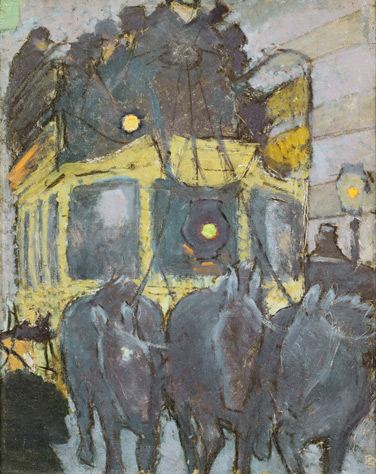Fr : version française / En: english version

Omnes omnibus
The philosopher and mathematician Blaise Pascal was thought to be the inventor of urban public transit: in 1662, he invested in a public coach company which operated five lines in Paris. The routes, schedules and fares were fixed. Despite a promising beginning, the company went bankrupt after 15 years.
In 1826 Stanislas Baudry, the owner of a flour mill in Nantes, had the idea of opening a public baths (the bath's return to favor...) to make use of the hot water discharged by his steam engines. However, the baths were too far out of the town center to make any money. To attract customers, he picked up on the idea of another Nantes man, Etienne Bureau, who had set up a horse-drawn coach service to shuttle his grandfather's employees to the warehouses on the outskirts of town. The coach stop was in front of the premises of a hatter by the name of Omnès whose sign read "Omnès Omnibus" - a pun on the Latin phrase "Unus pro omnibus, omnes pro uno" - which meant "Omnès for all". The passengers got into the habit of calling the service the "omnibus". The word stuck and gave rise to the modern terms autobus, bus, etc. in practically every language. The people of Nantes immediately took to the omnibus, not to go to the baths as Baudry had hoped but to get from A to B. In 1828, realizing the implications of his success, Baudry closed the baths and the flour mill and went to Paris to set up the Compagnie Générale d'Omnibus. He had a hard time convincing the Prefect Debelleyme to introduce this new form of transportation; he was afraid of the disruption caused by repeated stopping of coaches in the capital's already congested streets. Success was short-lived. Baudry quickly fell into financial ruin which led him to take his own life. The idea, however, gained ground.
The concept of public transit would not reappear until 150 years later when Stanislas Baudry introduced an omnibus service in Nantes, though not without difficulty.
Two extracts from L'Omnibus Panthéon-Courcelles, a one-act musical fantasy by Georges Courteline (music by Claude Terrasse)
« [...]
The thing about the Panthéon-Courcelles omnibus is that it is incapable of passing a street without rushing down it head first, or a kiosk or a public urinal without immediately going around it. It is crazy and unpredictable, and in some respects reminiscent of that astonishing Sceaux railroad which used to wear itself out chasing its tail in the hope of catching up with it. With the result that the concierges of the apartment buildings it passes on the way cast suspicious glances in its direction, manifestly afraid of seeing it suddenly dash under the porch of the building they are charged with looking after! Fortunately, it is used to the ways of society, it knows that one doesn't walk into people's houses without knocking; and it is thus that, having finally, without too many eccentric twists and turns, reached the Boulevard Saint-German, it stops to catch its breath;--which it has certainly earned.
[...]
By this time, a glum expression is painted on the faces of the poor passengers. As if they have been touched by the supernatural, they exchange anxious looks and think that one could quite easily replace the word "Full" immobilized above the driver's cap with the divine Dante's line: "Lasciate ogni speranza". You are right, you poor wretches; in the depths of your being, allow the gentle, sweet-smelling flower of your comforting illusions to die! And you, son of Mars and Bellona, white-gloved cuirassier, you who, underneath the steel that so becomes you, wears a heart devoid of weakness, crosses your arms resignedly across your broad breast, and, alas! hearing once again the brakes of the omnibus that was carrying you to your love, shudder in your breeches, abandon, on the corner of the Boulevard Extérieur where there is yet another stop, the idea of tasting Margot's lips".
The Panthéon-Courcelles Omnibus
While preparing to enter art school, Bonnard did numerous sketches of scenes from Parisian life. In 1895, he drew the Panthéon-Courcelles Omnibus from life. At the time, this lumbering double-decker coach carrying 40 passengers and drawn by three horses was one of the busiest lines run by Compagnie Générale des Omnibus. Bonnard managed to capture its power thanks to a bold low viewing angle. This small oil on board, now at the Fondation Bemberg in Toulouse, in 1899 was used for the cover of the first edition of Georges Courteline's musical L'omnibus Panthéon-Courcelles which makes fun of the line's legendary slowness.
Pierre Bonnard
Pierre Bonnard
Pierre Bonnard, born in Fontenay-aux-Roses in 1867, was initially part of the Nabi group, along with Vuillard, Vallotton and Maurice Denis. He had met Vuillard at the Ecole des Beaux-Arts in Paris where he went in 1888 after obtaining a law degree. He was fond of Japanese art which gave him an unusual conception of space, with off-center arrangements, no perspective and rich decorative motifs. He became a lawyer in 1890 and spent his time drawing his fellow lawyers in court. In 1893 he met Marthe, who became his model and companion. In the early 20th century he traveled, to Italy, Spain, Belgium and Holland. On his return, his art gradually moved away from the Nabi and his palette lightened. He painted a lot of nudes and developed a passionate interest in the play of light on the body. When he met Monet in 1912, he tried his hand at landscapes but very quickly restricted the space to a garden, an interior or a bathroom, the intimate places where he could combine the play of light on the skin with decorative motifs - flowers, plants, tiles, drapes, etc. He retired to the south of France where he kept company with Matisse and died at Canet in 1947.










